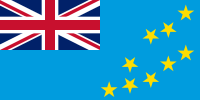Related Research Articles
Amatuku is an islet of Funafuti, Tuvalu on which the Tuvalu Maritime Training Institute is located. Access to Amatuku is from Tengako, which is the peninsula at the north end of Fongafale islet.
Avalau is an islet within the atoll of Funafuti, Tuvalu. Charles Hedley described Avalau in 1896 "this islet is said to possess a spring of fresh water".
Falaoigo is an uninhabited islet of Funafuti, Tuvalu.
Fatato is an uninhabited islet (motu) of Funafuti, Tuvalu. In 2003 the Asian Pacific Network (APN) chose this island for a systematic study of its coast in relation to the impact of global climate change on atolls.
Funafala is an islet of Funafuti, Tuvalu that is inhabited by five families, with a church also located on the islet. Funafala means 'the pandanus of Funa', the name of a chief, after whom also the group has been named Funafuti.
Fuagea is an islet located in the archipelago of Tuvalu in the south-western part of the atoll of Funafuti.

Fualefeke is a small islet of Funafuti, Tuvalu.
Fualopa is an islet of Funafuti, Tuvalu. It is part of the Funafuti Conservation Area, established in 1996 with the aim of preserving the natural fauna and flora of the area. Fualopa hosts a breeding colony of black noddy.
Mateika or Mateiko is an uninhabited islet of Funafuti, Tuvalu.
Motuloa is an islet in the atoll of Funafuti, Tuvalu. Motu loa means long island. It lies on the southeastern rim of the atoll and is 800 m long northeast-southwest, but only 50 m wide. It is only about 25 m southwest of Telele and can be reached by foot from it during low tide. The islet is densely vegetated.
Mulitefala is an islet of Funafuti, Tuvalu.
Te Afuafou is an islet of Funafuti, Tuvalu. Charles Hedley in 1896 describes the meaning of the name 'Te afua fou' as being 'the new beginning':
the name refers to an unfortunate incident in connection with their first contact with the white man, and their first knowledge of the deadly firearms of the foreigner. A vessel called at the mouth of the lagoon, and the natives were allowed on board. On leaving one of them stole a bucket. The canoe. containing the thief was pursued, and, to the astonishment and dismay of the company, the man in pursuit was able to produce lightning and thunder and to inflict death.
Te Afualiku is an islet of Funafuti, Tuvalu.
Telele is an uninhabited islet of Funafuti, Tuvalu.
Tengasu is an uninhabited islet of Funafuti, Tuvalu.
Tutanga is an uninhabited islet of Funafuti, Tuvalu.
Vasafua is an islet of Funafuti, Tuvalu. Vasafua is part of the Funafuti Conservation Area, established in 1996 with the aim of preserving the natural fauna and flora of the area.
Fale Fatu is an islet of Funafuti, Tuvalu. Te Ava Pua Pua is the passage through the reef, with a least depth of 12.7 metres, between the islets of Funamanu to the north and Fale Fatu to the south, in the southeast of Funafuti atoll.
Papa Elise is an islet of Funafuti, Tuvalu. The name Papa Elise is a translation of Father Ellice, and refers to a missionary who came to Funafuti in the late 19th century.
References
- ↑ Map of Funafuti. Tuvaluislands.com.
- ↑ Admiralty Nautical Chart 2983 Tuvalu - Funafuti atoll. United Kingdom Hydrographic Office (UKHO).
Coordinates: 8°38′33″S179°04′51″E / 8.6426°S 179.08088°E
| This Tuvalu location article is a stub. You can help Wikipedia by expanding it. |
